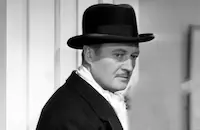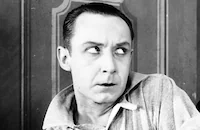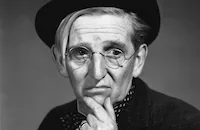Call Out the Marines

Brief Synopsis
Cast & Crew
Frank Ryan
Victor Mclaglen
Edmund Lowe
Binnie Barnes
Paul Kelly
Robert Smith
Film Details
Technical Specs

Synopsis
After a fifteen-year separation following their return to civilian life, marine sergeants Jimmy McGinnis and Harry Curtis meet accidentally at a race track. There, Harry becomes attracted to Vi Hall, who tells him she is a hostess at the Shoreleave Café, a serviceman's bar near the waterfront. While visiting Vi at the café, Jimmy and Harry meet their former commander, Jim Blake, who is now running the bar. Blake explains that he was discharged when he fell under suspicion for stealing some codebooks. When the sergeants are called back into active service, they continue to frequent the café and compete for the attentions of Vi. Vi, who is really a foreign agent, is plotting with Blake to steal plans from the general's office. When Blake suggests bribing marine private Billy Harrison to purloin the plans, Vi decides to circumvent Blake and arranges for Billy to meet the head of the spy ring at the café that night. When the boss mistakes Jimmy and then Harry for Billy and asks them for the plans, the sergeants become suspicious, but Blake warns them not to become involved. Consequently, when the plans are discovered missing, the sergeants suspect Blake and go to the café to investigate. In reality, Billy did not steal the plans but is working with Blake, a marine major, to apprehend the spy ring. As Blake and Billy meet with Vi, the sergeants burst in, and the spies flee in their car with the sergeants in pursuit aboard a motorcycle. When the spies crash their car into the café, the sergeants arrive just in time to see Blake arrest the gang and smash the spy ring.

Cast

Victor Mclaglen

Edmund Lowe

Binnie Barnes

Paul Kelly
Robert Smith
Dorothy Lovett

Franklin Pangborn
Corinna Mura
George Cleveland
King's Men
Six Hits And A Miss

Fortunio Bonanova
Murray Alper
Alan Davis
Ralph Brooks
Chester Tallman

James Conlin

Marie Windsor
Jane Woodworth

Marion Martin
Andrew Tombes
Harry Holman

Bob Carson
Rosemary Coleman

Louise Currie
Fred Aldrich
Eddie Hart

Richard Martin
Wayne Mccoy
Martha Mears
William Ruhl
Buddy Roosevelt
Charles Flynn
George Lloyd
Gordon De Main

Eddie Kane
Al Herman
Lew Harvey
Don Brodie
Forbes Murray
Helen Mcleod
James Carlisle
Bert Moorhouse
Sam Harris
Norman Mayes
George Chandler
The Three Jays
Florence Gill
Nora Cecil
Eva Mckenzie
Crew
C. Bakaleinikoff
Howard Benedict
Carroll Clark
Doran Cox
Albert S. D'agostino
Harry D'arcy
Mort Greene
William Hamilton
J. Roy Hunt
J. R. Mcdonough
Nicholas Musuraca
Renie
Harry Revel
Gene Rose
Frank Ryan
Captain T. M. Ryan
Darrell Silvera
Richard Van Hessen
Vernon L. Walker
Theron Warth

Film Details
Technical Specs

Articles
Call Out the Marines
Despite the title and its wartime setting, Call Out the Marines is actually an espionage comedy with songs and less of a war movie; it features two Marine sergeants who become involved with a dockside Mata Hari. She's played by British actress Binnie Barnes, who made her first big mark on screen as Katherine Howard, the fifth wife of Charles Laughton's Henry the Eighth and the second to lose her head, in The Private Life of Henry VIII (1933). She was brought to Hollywood the following year, where for the next decade she made a career out of playing major supporting roles, among them was her role as real-life turn-of-the-century icon Lillian Russell to Edward Arnold's Jim Brady in Diamond Jim (1935). Barnes, who two years before this picture married football star and later producer Mike Frankovich, had no grand illusions about her screen career and once said, "I'm no Sarah Bernhardt. One picture is just like another to me as long as I don't have to be a sweet woman."
Call Out the Marines is further enlivened by the inclusion of several songs by Mort Greene and Harry Revel, who this same year composed the Oscar®-nominated song "There's a Breeze on Lake Louise" from the movie The Mayor of 44th Street (1942). There are no such accolades for the songs here, and titles like "Zana Zaranda" and "Hands Across the Border" have hardly passed into the classic repertoire. But Greene, at least, achieved a certain level of immortality with his composition of the theme song for the TV series Leave It to Beaver.
Call Out the Marines was enough of a hit to lead the producing studio, RKO, to consider starting a new series with the two male leads, but it never happened. However, 14 years later Lowe and Oscar®-winner McLaglen (The Informer, 1935) renewed their act for a bit in the international hit Around the World in 80 Days (1956).
Director: Frank Ryan
Producer: Howard Benedict
Screenplay: William Hamilton, Frank Ryan
Cinematography: J. Roy Hunt, Nicholas Musuraca
Editing: Theron Warth
Art Direction: Carroll Clark, Albert S. D'Agostino
Original Music: Mort Greene, Harry Revel
Cast: Victor McLaglen (Jimmy McGinnis), Edmund Lowe (Harry Curtis), Binnie Barnes (Violet Hall), Paul Kelly (Jim Blake), Franklin Pangborn (Wilbur).
BW-68m.
by Rob Nixon

Call Out the Marines
Quotes
Trivia
Notes
The working title of this film was The Marines Are Ready. The film had a long and troubled production history. According to a May 1941 news item in Hollywood Reporter, Jack Hively was slated to direct, and James Edward Grant to write the screenplay for the film, which was to star Tim Holt, Jack Holt, Anne Shirley and Simone Simon. A July 1941 news item in Hollywood Reporter noted that because production was delayed due to script problems, Anne Shirley and Jack Hively were leaving to work on Four Jacks and a Jill (see below). At that time, Leslie Goodwin was to replace Hively as director, but was later re-assigned to direct Mexican Spitfire at Sea (see below). One week later, a news item in Hollywood Reporter reported that Victor McLaglen and Edmund O'Brien were to be the new stars of the film, which would also feature a comedy role by Harry Langdon. The Variety review notes that the Marine sergeants played by McLaglen and Lowe were loosely based on the World War I soldiers "Flagg" and "Quirt" they portrayed in a series of pictures that began with the 1926 Fox production What Price Glory? (see AFI Catalog of Feature Films, 1921-30; F2.6213). Although a Hollywood Reporter news item and the CBCS credit Andrew Bennison with special dialogue, he is not listed in any other source.
According to news items in Hollywood Reporter, the production initially enjoyed the full cooperation of the Marine Corps. News items note that Marine Captain T. M. Ryan served as technical advisor and backround shots were filmed on location at the Marine base in San Diego and the rifle range and training area at Camp Elliott. A special trailer was filmed as part of a Marine recruiting drive. Once the production was completed, however, the Marine Corps had second thoughts about the film's comic portrayal of the troops. In December 1941, the Marines ordered the studio to shelve the film because of fears that this service comedy would undermine the soldiers' moral. The film was finally released two months later.















